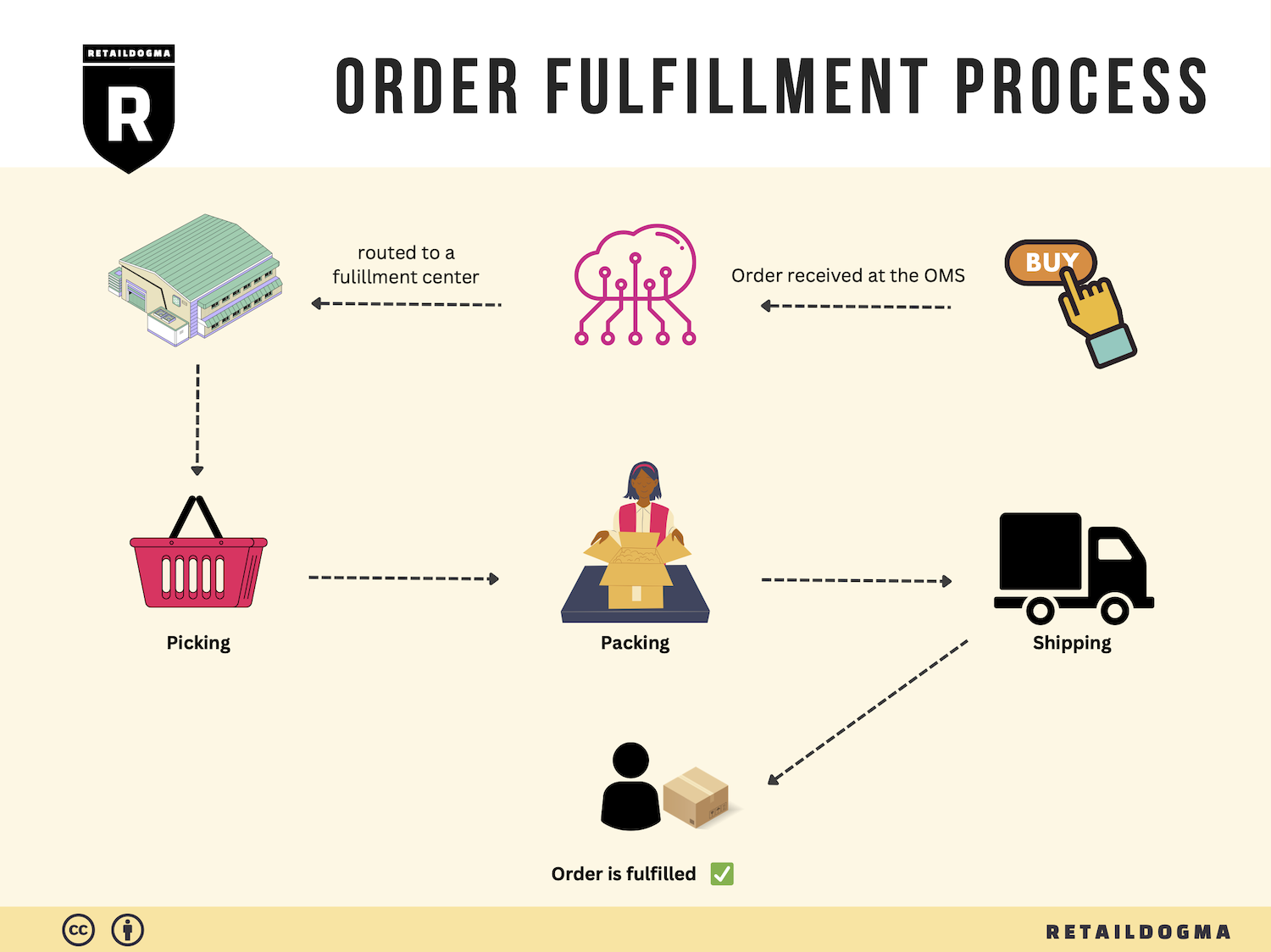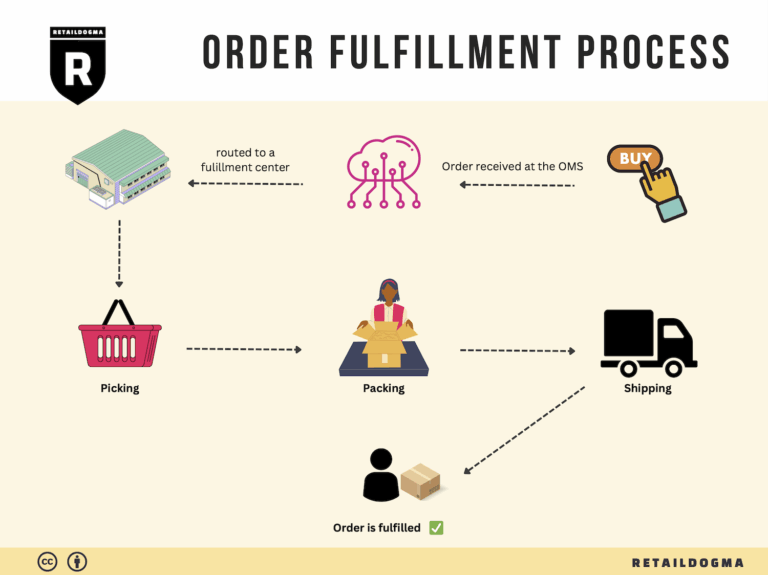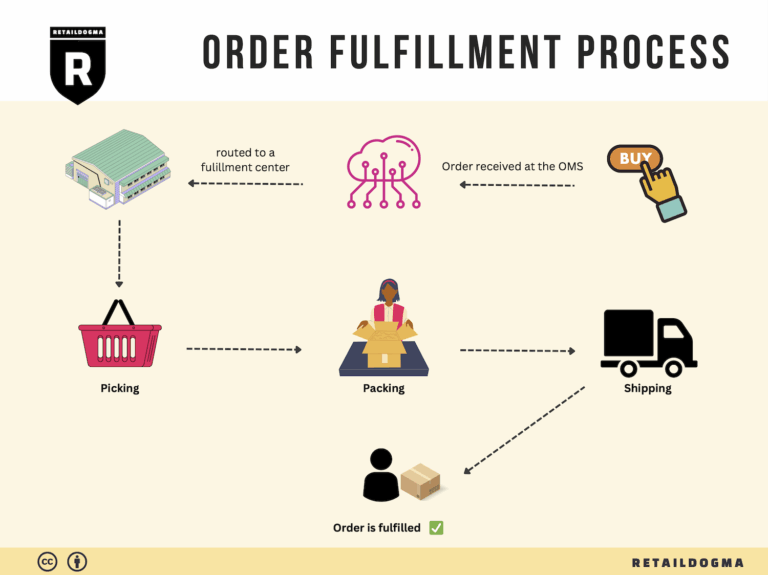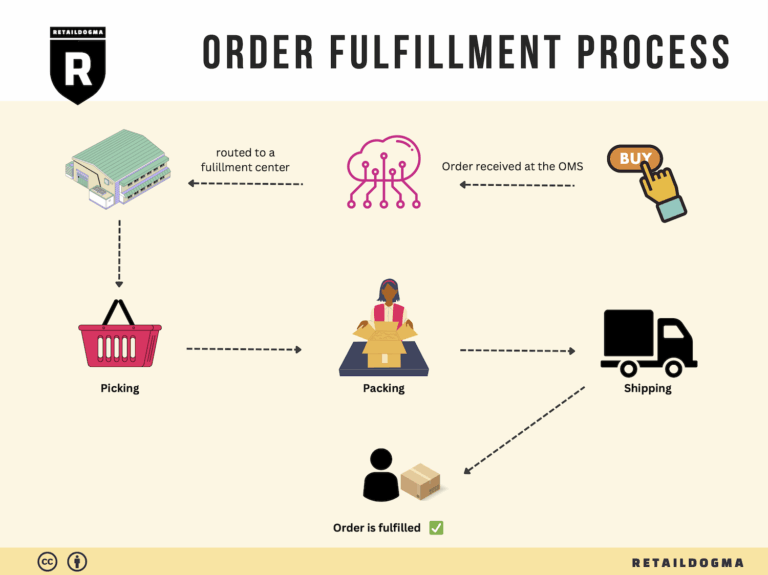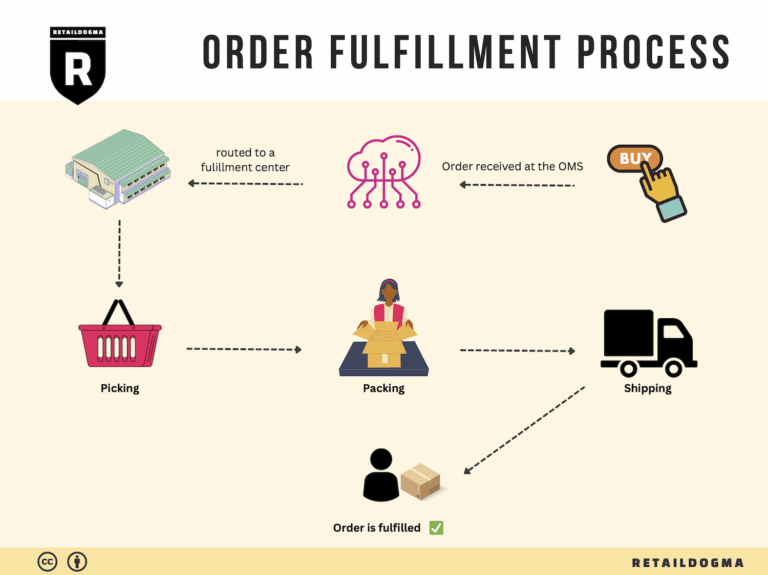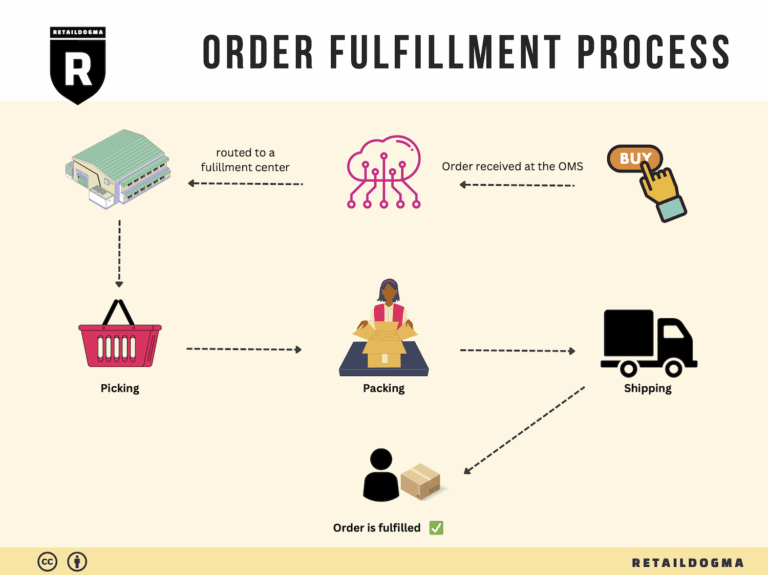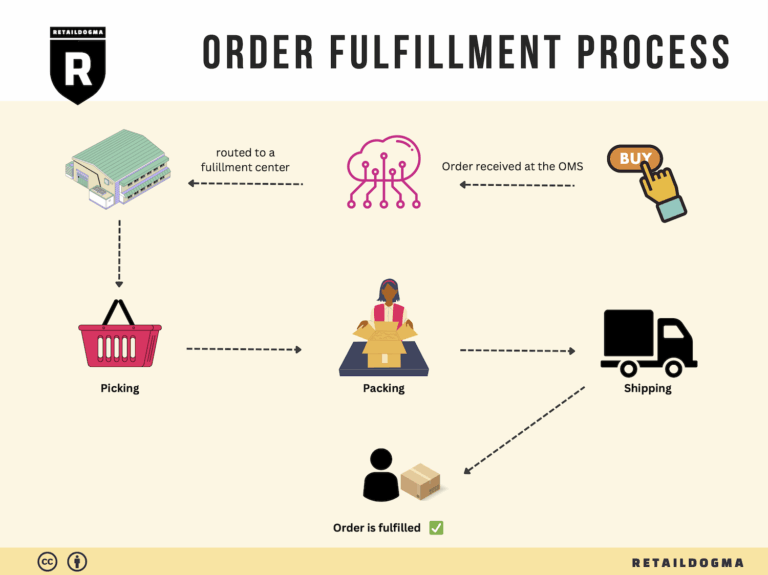Ecommerce Fulfillment Services: The Ultimate Guide (2025)
What is E-commerce Fulfillment? An Introduction for Growing Businesses
Understanding the E-commerce Fulfillment Process
As an e-commerce business owner, you may find yourself grappling with one of the most daunting challenges: managing the packing and shipping of orders. This essential task, while crucial for customer satisfaction, can quickly become overwhelming, especially as your business scales. Juggling inventory management, order processing, and shipping logistics can divert your focus from growth strategies, marketing, and customer engagement.
At its core, fulfillment is the process of getting a product from your inventory to your customer’s doorstep. This involves several steps, including order receipt, inventory management, picking and packing, and finally, shipping the product. Given the complexity of these tasks, many growing businesses turn to third-party logistics (3PL) providers or fulfillment centers to streamline their operations.
In this guide, we will explore various fulfillment models, including 3PL and Fulfillment by Amazon (FBA). We’ll break down the core services these providers offer, such as inventory storage, order processing, and shipping solutions. Understanding the differences between these models can help you determine which is best suited for your business needs.
Choosing the right fulfillment partner is crucial to your success. Factors to consider include the provider’s location, service offerings, technology integration, and pricing structures. We’ll provide practical insights on how to evaluate potential partners effectively, ensuring you make a choice that aligns with your operational goals and customer expectations.
Pricing is another essential element we’ll cover. Understanding the cost implications of different fulfillment options can help you budget effectively and avoid unexpected expenses. From storage fees to shipping costs, we’ll break down what to expect so you can plan accordingly.
The ultimate goal of this guide is to empower you to make informed decisions about your logistics strategy. By equipping you with the knowledge of e-commerce fulfillment, we aim to alleviate the stress associated with order management and enhance your ability to scale your business effectively. With the right fulfillment strategy in place, you can focus on what you do best—growing your brand and delighting your customers.
What You’ll Learn In This Guide
- What is E-commerce Fulfillment? An Introduction for Growing Businesses
- The Order Fulfillment Process: From ‘Buy’ Button to Customer’s Door
- Comparing Fulfillment Models: In-House vs. 3PL vs. Dropshipping
- A Deep Dive into Amazon FBA: Pros, Cons, and Who It’s For
- Core Services Offered by Fulfillment Centers
- How to Choose a Fulfillment Partner: A 6-Point Checklist
- Understanding Fulfillment Pricing: A Breakdown of Common Fees
- Frequently Asked Questions (FAQs) about Fulfillment
- Conclusion: Is Outsourcing Fulfillment the Right Move for Your Business?
- Important Disclaimer
The Order Fulfillment Process: From ‘Buy’ Button to Customer’s Door
1. Receiving Inventory
The order fulfillment process begins with the receiving of inventory, a critical step that lays the foundation for efficient operations. Upon arrival at the fulfillment center, products are unloaded from delivery trucks and checked against purchase orders to ensure accuracy. This process often involves the use of Stock Keeping Units (SKUs), which are unique identifiers assigned to each product.
Importance: Proper inventory receiving is vital as it prevents stock discrepancies and ensures that your records reflect what is physically available. Any errors at this stage can lead to issues further down the line, including stockouts or overstock situations, which can affect customer satisfaction and operational costs.
Key Term: SKU (Stock Keeping Unit) – A unique identifier for each product that aids in tracking inventory levels and sales.
2. Warehouse Storage
Once inventory has been received and verified, the next step is warehouse storage. This involves placing products in designated storage areas within the fulfillment center. Efficient warehouse layout and organization play a significant role in optimizing space and accessibility. Products are often stored based on their SKU, size, and turnover rate, utilizing methods such as FIFO (First In, First Out) or LIFO (Last In, First Out).
Importance: Effective storage solutions minimize retrieval times and maximize space utilization, which is essential for maintaining operational efficiency. By strategically organizing inventory, businesses can ensure that fast-moving items are easily accessible, which speeds up the order fulfillment process.
Key Term: FIFO (First In, First Out) – An inventory management method where the oldest stock is sold first, helping to reduce spoilage or obsolescence, particularly in perishable goods.
3. Order Picking
Order picking is the process of retrieving products from storage to fulfill customer orders. This step typically starts when a customer places an order online, triggering a pick list—a document that outlines which items to retrieve and their locations within the warehouse. Different picking methods may be employed, such as single order picking, batch picking, or wave picking, depending on the volume and nature of orders.

Importance: The efficiency of the picking process directly impacts the speed of order fulfillment. Errors in picking can lead to incorrect shipments, resulting in returns and dissatisfied customers. Therefore, implementing technology like barcode scanners or pick-to-light systems can enhance accuracy and efficiency during this phase.
Key Term: Pick List – A document or digital tool that lists the items needed to fulfill customer orders, guiding warehouse staff in the picking process.
4. Order Packing
After items have been picked, they are transported to the packing area where they are prepared for shipment. During this step, products are carefully packed into boxes, and packing materials are chosen based on the nature of the items being shipped. This could involve using bubble wrap for fragile items or eco-friendly materials for sustainability-focused brands.
Importance: Proper packing is essential not only for protecting items during transit but also for ensuring a positive customer experience. A well-packed order reflects professionalism and care, while poor packing can lead to damage and increased return rates. Additionally, accurate packing helps in calculating shipping costs effectively.
Key Term: Packing Slip – A document included in the package that lists the items contained in the shipment, serving as a receipt for the customer and as a reference for returns.
5. Shipping & Delivery
The final step in the order fulfillment process is shipping and delivery. Once orders are packed, they are labeled with shipping information and handed over to carriers for distribution. Businesses must choose the right shipping methods and carriers based on factors like cost, speed, and reliability. Options may include ground shipping, express delivery, or even same-day delivery, depending on customer expectations and geographic considerations.
Importance: The shipping and delivery phase is the last opportunity to impress the customer. Timely and accurate delivery can significantly enhance customer satisfaction and loyalty, while delays or issues can lead to negative reviews and lost sales. Effective tracking systems also enable both businesses and customers to monitor shipment progress.
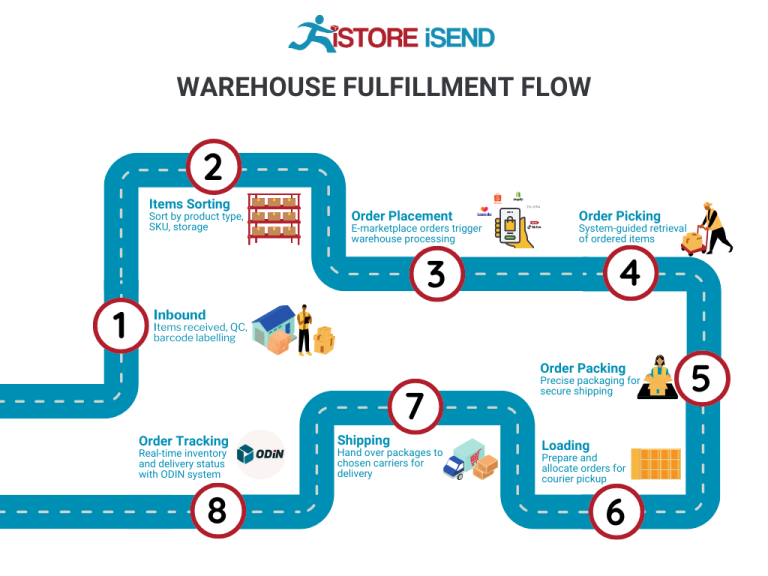
Key Term: Tracking Number – A unique identifier assigned to a shipment that allows customers to monitor the status and location of their package in real-time.
By understanding and optimizing each step in the order fulfillment process, e-commerce businesses can enhance their operational efficiency, reduce costs, and ultimately improve customer satisfaction. Each phase is interlinked, and attention to detail in one area can significantly impact the overall success of fulfillment operations.
Comparing Fulfillment Models: In-House vs. 3PL vs. Dropshipping
Fulfillment Model Comparison
| Model | Who Handles Inventory | Best For (Business Stage) | Key Advantage | Key Disadvantage |
|---|---|---|---|---|
| In-House Fulfillment | Business Owner/Staff | Established businesses | Full control over inventory and processes | Higher upfront costs and resource demands |
| Third-Party Logistics (3PL) | Third-Party Provider | Scaling businesses | Scalability and reduced operational burden | Less control over fulfillment processes |
| Dropshipping | Supplier | Startups/Small businesses | Low startup costs and no inventory management | Lower profit margins and dependency on suppliers |
In-House Fulfillment
In-house fulfillment involves managing the entire logistics process internally. This model is typically best suited for established businesses with stable sales volumes and sufficient resources. Companies that choose this model maintain direct control over their inventory, which allows for personalized customer service and streamlined operations. In-house fulfillment also enables businesses to implement their own quality control measures and adjust processes as necessary without relying on third-party providers. However, this model comes with significant drawbacks. The initial setup costs can be high, as businesses need to invest in warehousing, staffing, and technology. Additionally, the operational demands can strain resources, especially during peak seasons or unexpected surges in demand. As a result, while in-house fulfillment offers control and customization, it may not be the most efficient option for businesses looking to scale rapidly or manage fluctuating order volumes.
Third-Party Logistics (3PL)
Third-party logistics (3PL) providers offer a flexible and scalable fulfillment solution for businesses looking to grow without the burden of managing logistics themselves. This model is particularly advantageous for scaling businesses that want to focus on core operations such as marketing and sales. A 3PL can handle various aspects of logistics, including warehousing, inventory management, order fulfillment, and shipping, allowing businesses to benefit from their expertise and established networks. The key advantage of using a 3PL is the ability to scale operations quickly without the need for significant capital investment in infrastructure. However, there are disadvantages to consider. Relying on a third-party provider can lead to less control over fulfillment processes, which may impact customer satisfaction if service levels do not meet expectations. Additionally, businesses must carefully vet potential 3PL partners to ensure they align with their operational needs and values, as poor service or mismanagement can lead to negative repercussions for the brand.
Dropshipping
Dropshipping is a fulfillment model where the retailer does not keep products in stock but instead transfers customer orders directly to the supplier, who then ships the products directly to the customer. This model is ideal for startups and small businesses that are looking to minimize upfront costs and avoid the complexities of inventory management. With dropshipping, entrepreneurs can enter the e-commerce space with minimal financial risk, as they only pay for products after a sale is made. This model allows for a wide product range without the need for significant investment in inventory. However, dropshipping comes with its own set of challenges. Profit margins tend to be lower due to higher wholesale prices, and businesses are often at the mercy of suppliers regarding stock availability and shipping times. Additionally, the lack of control over inventory and fulfillment can lead to inconsistencies in customer experience, which may harm the brand’s reputation. While dropshipping can be an effective way to start an e-commerce business, it requires careful management of supplier relationships and customer expectations to succeed in a competitive market.
Conclusion
Choosing the right fulfillment model is a critical decision that can significantly impact an e-commerce business’s growth and operational efficiency. Each model—whether in-house fulfillment, third-party logistics, or dropshipping—has its own unique advantages and disadvantages. Business owners must carefully assess their current stage, resources, and long-term goals to determine which model aligns best with their operational strategy. As e-commerce continues to evolve, understanding these fulfillment options will empower entrepreneurs to make informed decisions that drive success and scalability in their logistics operations.
A Deep Dive into Amazon FBA: Pros, Cons, and Who It’s For
Understanding Fulfillment by Amazon (FBA)
Fulfillment by Amazon (FBA) is a service offered by Amazon that allows e-commerce sellers to store their products in Amazon’s fulfillment centers. Amazon then takes care of storage, packaging, shipping, and customer service on behalf of the sellers. This service is designed to simplify the logistics of running an online business, allowing sellers to focus more on product development and marketing.
How FBA Works
-
Product Preparation: Sellers prepare their products according to Amazon’s guidelines, which include labeling and packaging requirements.
-
Shipping to Amazon: Sellers send their inventory to Amazon’s designated fulfillment centers. Amazon has multiple warehouses across various locations, which helps in optimizing shipping times.
-
Storage: Once the products arrive at the fulfillment center, they are stored until sold. Amazon manages the inventory, ensuring that products are readily available for shipping.
-
Order Processing: When a customer places an order for a seller’s product on Amazon, the order is processed through Amazon’s system. Amazon picks, packs, and ships the product directly to the customer.
-
Customer Service and Returns: Amazon also handles customer service inquiries and returns for FBA orders, which can significantly reduce the operational burden on sellers.

-
Payments: After the sale, sellers receive payment from Amazon, minus any applicable fees.
Pros of Using FBA
-
Prime Eligibility: One of the most significant advantages of using FBA is that products become eligible for Amazon Prime. This feature attracts a large customer base that prefers fast, free shipping, increasing the likelihood of sales.
-
Customer Trust: Products fulfilled by Amazon benefit from the credibility and trust associated with the Amazon brand. Customers often feel more comfortable purchasing items that are backed by Amazon’s customer service and return policies.
-
Multi-Channel Fulfillment: FBA can be used to fulfill orders from other sales channels, such as eBay or a seller’s own website. This capability allows sellers to streamline their logistics processes and manage their inventory more efficiently.
-
Scalability: As businesses grow, FBA can easily scale with them. Sellers can increase their inventory and reach more customers without needing to invest heavily in warehousing or logistics infrastructure.
-
Time Savings: FBA significantly reduces the time sellers spend on order fulfillment and customer service, allowing them to concentrate on other critical aspects of their business, such as marketing and product development.
Cons of Using FBA
-
High Fees: FBA comes with various fees, including storage fees and fulfillment fees. These costs can add up, particularly for sellers with low-margin products or those who do not sell quickly.
-
Strict Inventory Rules: Amazon has specific rules regarding inventory management, including limits on the amount of inventory that can be stored in their warehouses. Sellers must be diligent in managing their inventory levels to avoid incurring excess storage fees or having their products removed.
-
Commingling Risks: When using FBA, sellers’ products may be commingled with inventory from other sellers. This means that if a customer receives a defective or non-compliant product, it can reflect poorly on the original seller, even if they were not responsible for the issue.
-
Less Control Over Fulfillment: By outsourcing fulfillment to Amazon, sellers relinquish some control over the packaging and shipping processes. This lack of control can affect the customer experience, especially for brands that prioritize unique packaging.
-
Competition: Sellers using FBA are often competing with Amazon itself, as well as other FBA sellers. This competition can lead to price wars, diminishing profit margins.
Who is FBA Best For?
FBA is particularly beneficial for small to medium-sized e-commerce businesses that want to expand their reach without the complexity of managing logistics. Here are some specific scenarios where FBA might be the right fit:
-
Entrepreneurs with Limited Resources: New sellers or those with limited resources can leverage FBA to access Amazon’s vast logistics network without the need to invest in warehousing or shipping infrastructure.
-
Sellers with High Turnover Products: Businesses that sell fast-moving consumer goods can benefit from FBA, as they can utilize the service to ensure quick shipping times and increased sales volume.
-
Brands Seeking to Build Trust: For brands that are new or not well-established, FBA can provide a boost in credibility, as customers are more likely to purchase products that are fulfilled by Amazon.
-
Multi-Channel Sellers: Businesses that sell on multiple platforms can streamline their operations by using FBA to fulfill orders from various sales channels, reducing complexity and time spent on logistics.
-
Businesses Wanting to Scale: Companies looking to grow quickly without the overhead of logistics can benefit from FBA’s scalability. They can increase their inventory and sales without needing to manage fulfillment operations themselves.
In conclusion, while FBA offers numerous advantages such as Prime eligibility, customer trust, and operational efficiency, it is crucial for sellers to weigh these benefits against the potential downsides, including high fees and limited control over fulfillment. Understanding the unique needs of your business will help determine if FBA is the right fulfillment solution as you scale your e-commerce operations.
Core Services Offered by Fulfillment Centers
Inventory Management & Warehousing
Inventory management and warehousing are foundational services provided by fulfillment centers. This involves the systematic handling, storage, and tracking of products from the moment they arrive at the warehouse until they are shipped to customers. Fulfillment centers utilize sophisticated inventory management systems that integrate with e-commerce platforms to provide real-time updates on stock levels, order statuses, and product locations.
Benefits:
1. Efficiency and Accuracy: Automated systems reduce human error and streamline the inventory process. This ensures that businesses have accurate data on stock levels, minimizing the risk of overstocking or stockouts.
2. Cost Savings: By optimizing inventory levels, businesses can reduce holding costs associated with excess inventory. Moreover, effective inventory management helps in forecasting demand accurately, which can lead to better purchasing decisions.
3. Space Utilization: Fulfillment centers are designed to maximize warehouse space, enabling businesses to store a larger quantity of products without requiring extensive real estate investments. This is particularly beneficial for e-commerce businesses that experience seasonal fluctuations in demand.
Pick and Pack Services
Pick and pack services refer to the process of selecting products from the warehouse (picking) and packaging them for shipment (packing). Fulfillment centers employ efficient picking strategies, such as batch picking or wave picking, to fulfill orders quickly and accurately. Once items are picked, they are carefully packed to ensure they arrive at the customer’s doorstep in pristine condition.
Benefits:
1. Speed and Scalability: Fulfillment centers are equipped with trained staff and technology that enable rapid order fulfillment. As e-commerce businesses grow, these centers can easily scale operations to handle increased order volumes without compromising service quality.
2. Customization: Many fulfillment centers offer customizable packing options, including branded packaging and gift wrapping. This enhances the customer experience and can improve brand loyalty.
3. Reduced Labor Costs: Outsourcing pick and pack services can significantly reduce the labor burden on e-commerce businesses. Companies can focus their resources on core business functions like marketing and product development, rather than logistics.
Kitting and Assembly
Kitting and assembly are value-added services that involve assembling multiple products into a single package or creating a unique product offering from various components. This service is particularly useful for businesses that sell complex products that require some assembly before shipping, or for those that wish to bundle products together for promotions.
Benefits:
1. Enhanced Product Offerings: By offering kitted products, businesses can create unique bundles that appeal to customers, potentially increasing average order value and customer satisfaction.
2. Streamlined Operations: Kitting reduces the number of SKUs (stock-keeping units) that need to be managed separately, simplifying inventory management and fulfillment processes.
3. Time Savings: By utilizing fulfillment centers for kitting and assembly, e-commerce businesses can save significant time and resources that would otherwise be spent on these labor-intensive tasks.
Returns Management (Reverse Logistics)
Returns management, or reverse logistics, is the process of handling returned products efficiently. This includes receiving, inspecting, restocking, and processing refunds or exchanges. Fulfillment centers often have dedicated teams and systems in place to manage returns seamlessly.
Benefits:
1. Customer Satisfaction: A smooth returns process enhances the overall customer experience. When customers know they can easily return products, they are more likely to make a purchase, knowing they have options if the product doesn’t meet their expectations.
2. Cost Efficiency: Effective returns management minimizes losses associated with returned goods. Fulfillment centers can quickly assess the condition of returned items and determine whether they can be restocked, refurbished, or need to be disposed of, thereby maximizing recovery value.
3. Data Insights: Returns management provides valuable data on customer preferences and product quality. Analyzing return reasons can help businesses refine their product offerings and improve future sales strategies.
In conclusion, fulfillment centers provide a suite of core services that are essential for e-commerce businesses looking to scale efficiently. By leveraging these services, companies can streamline their operations, reduce costs, and enhance customer satisfaction, ultimately driving growth and profitability in a competitive market.
How to Choose a Fulfillment Partner: A 6-Point Checklist
Location & Warehouse Network
Importance:
The geographical location of your fulfillment partner plays a critical role in reducing shipping costs and improving delivery times. A strategically located warehouse can significantly enhance your logistics efficiency, especially in e-commerce, where customer expectations for quick delivery are high.
Questions to Ask:
– Where are the fulfillment centers located, and how do they align with my customer base?
– Do you have a network of warehouses that can ensure coverage across key regions?
– How do you manage shipping costs associated with both inbound and outbound logistics?
Technology & Integrations
Importance:
Modern fulfillment operations rely heavily on technology to streamline processes and enhance visibility. A partner with robust technology solutions can offer real-time tracking, inventory management, and seamless integration with your e-commerce platform, helping you maintain operational efficiency.
Questions to Ask:
– What technology platforms do you use for inventory management and order processing?
– Can your systems integrate with my existing e-commerce platforms (e.g., Shopify, WooCommerce)?
– Do you provide real-time tracking and reporting features for orders?
Specializations (e.g., Cold Storage, Oversized Items)
Importance:
Different businesses have unique needs based on their product types. If your products require special handling—such as temperature-controlled storage for perishables or specific handling for oversized items—it’s crucial to ensure your fulfillment partner has the necessary capabilities.
Questions to Ask:
– Do you have specialized facilities for handling specific types of products (e.g., cold storage, fragile items)?
– What certifications do you hold that demonstrate compliance with industry standards for specialized storage?
– How do you manage the unique logistics challenges associated with my product types?
Scalability & Capacity
Importance:
As your business grows, your fulfillment needs will evolve. Choosing a partner that can scale with you ensures that you won’t face capacity constraints during peak seasons or when your business experiences sudden growth.
Questions to Ask:
– What is your current capacity, and how have you managed scaling in the past?
– Can you accommodate seasonal fluctuations in order volume?
– What processes do you have in place to ensure that you can scale operations without compromising service quality?
Pricing and Contracts
Importance:
Understanding the pricing structure of your fulfillment partner is essential to maintain profitability. Transparent pricing and flexible contract terms can help you avoid unexpected costs and ensure that you’re getting value for your investment.
Questions to Ask:
– Can you provide a detailed breakdown of your pricing structure (e.g., storage fees, pick and pack fees, shipping costs)?
– Are there any additional costs that I should be aware of?
– What are the terms of the contract, and is there flexibility for renegotiation as my business needs change?
Customer Support & Reviews
Importance:
Effective customer support can make or break your relationship with a fulfillment partner. A responsive partner can help resolve issues quickly, minimizing disruptions to your operations. Additionally, customer reviews can provide insights into the partner’s reliability and service quality.
Questions to Ask:
– What kind of customer support do you offer (e.g., dedicated account manager, 24/7 support)?
– Can you provide references or case studies from clients in my industry?
– How do you handle disputes or issues that arise during the fulfillment process?
Conclusion
Choosing the right fulfillment partner is a crucial step in scaling your e-commerce business. By carefully evaluating potential partners using this checklist, you can ensure that you select a fulfillment center that aligns with your operational needs and growth ambitions. Taking the time to ask the right questions will not only help you find a capable partner but also pave the way for a successful and collaborative relationship.
Understanding Fulfillment Pricing: A Breakdown of Common Fees
Initial Setup Fees
Initial setup fees are one-time charges that fulfillment centers may impose when you first engage their services. These fees can vary widely depending on the provider and the complexity of your inventory. Common components of initial setup fees include:
- Account Setup: This includes creating your account in their system, configuring necessary software integrations, and onboarding your business.
- Inventory Setup: If you have a large or complex inventory, there might be additional costs for entering your product information into the fulfillment center’s system.
- Warehouse Configuration: Depending on your needs, the fulfillment center may require a specific layout for your products, which can incur additional costs.
To get an accurate understanding of initial setup fees, it’s essential to ask potential providers for a detailed breakdown of what is included in their fees and whether there are any additional costs for specific services.
Receiving Fees
Receiving fees are charged for the process of accepting your inventory into the fulfillment center. This fee typically covers:
- Unloading: The cost associated with unloading your products from trucks or containers.
- Inspection: Checking the inventory for any damages or discrepancies against the shipping documents.
- Inventory Entry: Entering the received items into the fulfillment center’s inventory management system.
Receiving fees are usually calculated per hour or per pallet. For instance, if a fulfillment center charges $50 per hour and it takes two hours to unload and inspect your products, your receiving fee would be $100. It’s crucial to confirm how these fees are structured and whether there are minimum charges.
Storage Fees (per pallet/bin)
Storage fees are recurring charges for keeping your inventory in the fulfillment center. These fees can vary based on the following factors:
- Storage Type: Some centers offer different types of storage, such as standard, climate-controlled, or specialized storage for sensitive items, which can affect the fee.
- Volume: Storage fees are typically calculated on a per-pallet or per-bin basis. For example, a center may charge $20 per pallet per month. If you have 10 pallets, your monthly storage fee would be $200.
It’s important to understand the storage duration as many fulfillment centers have different pricing structures for long-term storage versus short-term storage. Be sure to clarify any additional fees that may apply if your inventory remains in storage for longer than a specified period.
Pick & Pack Fees (per item/order)
Pick & pack fees are charged for the labor involved in retrieving items from storage and preparing them for shipment. This fee is typically calculated based on:
- Picking: The cost of selecting items from the warehouse, often charged per item. For instance, if the fee is $1 per item and you order 100 items, the picking fee would be $100.
- Packing: The cost of packing the items into boxes, which may include the price of packing materials. Some fulfillment centers bundle picking and packing fees together, while others separate them.
Understanding how pick & pack fees are structured is critical, especially for e-commerce businesses where order volumes can fluctuate. Request a detailed explanation of what is included in the pick & pack fee and any additional costs for special packing requirements.
Shipping Fees
Shipping fees are the costs associated with transporting your products from the fulfillment center to your customers. These fees can vary based on several factors:
- Shipping Method: Options may include standard ground, expedited, or international shipping, each with its own cost structure.
- Weight and Dimensions: Most fulfillment centers calculate shipping fees based on the weight and size of packages. Heavier or larger items typically incur higher shipping costs.
- Destination: The shipping distance and destination can significantly impact fees. Shipping to remote areas may result in higher charges.
To accurately assess shipping fees, it’s advisable to understand the fulfillment center’s relationships with carriers and whether they offer discounted rates. Request examples of shipping costs based on your product types and shipping destinations.
Tips for Getting an Accurate Quote
-
Provide Detailed Information: When requesting quotes, provide as much detail as possible about your inventory, order volume, and specific needs. This will help fulfillment centers give you a more accurate estimate.
-
Ask for Itemized Quotes: Request itemized quotes that break down each fee type. This transparency will help you compare different providers more effectively.
-
Inquire About Additional Fees: Always ask about potential hidden fees, such as for returns, customer service, or inventory management. Understanding the full cost structure will prevent surprises later.
-
Negotiate Terms: Don’t hesitate to negotiate terms with fulfillment centers, especially if you plan to scale your business. Many providers are open to adjusting fees based on expected order volumes.
-
Evaluate Contract Terms: Carefully review any contracts for terms related to pricing adjustments, minimum monthly fees, and other conditions that could affect your overall costs.
By understanding these common fulfillment pricing models and following these tips, you can make informed decisions that support your business growth while managing costs effectively.
Frequently Asked Questions (FAQs) about Fulfillment
1. What is a fulfillment center?
A fulfillment center is a specialized warehouse where e-commerce businesses store their products, manage inventory, and handle order processing. When a customer places an order, the fulfillment center picks, packs, and ships the product directly to the customer, often providing tracking information and returns management.
2. What’s the difference between a warehouse and a fulfillment center?
While both warehouses and fulfillment centers store products, their purposes differ significantly. A warehouse primarily focuses on storing inventory for long-term use, whereas a fulfillment center is designed for processing orders quickly and efficiently, including picking, packing, and shipping items to customers.
3. What is a 3PL?
A Third-Party Logistics (3PL) provider is a company that offers logistics services, including warehousing, fulfillment, transportation, and distribution. E-commerce businesses often partner with 3PLs to outsource their supply chain management, allowing them to focus on core business activities while leveraging the expertise and infrastructure of the 3PL.
4. How much do fulfillment services cost?
The cost of fulfillment services varies based on several factors, including order volume, storage space needed, shipping methods, and additional services like returns processing. Generally, fulfillment providers charge a combination of storage fees, per-order fulfillment fees, and shipping costs. It’s advisable to request quotes from multiple providers to find a solution that fits your budget.
5. How do I choose the right fulfillment center near me?
When selecting a fulfillment center, consider factors such as location relative to your customer base, shipping costs, service offerings (like returns management), technology integration, and pricing structure. It’s crucial to evaluate their ability to scale with your business and their reputation in the industry.
6. What factors impact shipping costs from a fulfillment center?
Shipping costs are influenced by several factors, including the distance to the customer, shipping carrier rates, package size and weight, and the chosen shipping method (e.g., standard, expedited). Additionally, fulfillment centers located closer to high-density customer areas can reduce outbound shipping costs, improving overall profitability.
7. Can a fulfillment center help with international shipping?
Yes, many fulfillment centers offer international shipping services, allowing businesses to reach customers globally. They typically handle customs clearance and provide various shipping options to ensure timely delivery. However, it’s essential to verify that the fulfillment center has experience with international logistics and compliance.
8. How does inventory management work in a fulfillment center?
Inventory management in a fulfillment center involves tracking stock levels, managing replenishment, and ensuring accurate order fulfillment. Many fulfillment centers utilize advanced technology, such as inventory management software, to provide real-time data on stock levels, automate reordering processes, and minimize the risk of stockouts or overstock situations.
9. What are the benefits of using a fulfillment center?
Utilizing a fulfillment center can significantly enhance operational efficiency by streamlining order processing, reducing shipping times, and minimizing overhead costs. It allows businesses to scale without investing in warehousing infrastructure, provides access to expert logistics services, and often results in better shipping rates due to the volume of orders processed.
10. How can I ensure quality control when using a fulfillment center?
To maintain quality control, establish clear communication channels with your fulfillment center, set standards for order accuracy and packaging, and conduct regular audits of inventory and processes. Additionally, consider implementing quality control checks at various stages of the fulfillment process to identify and rectify any issues promptly.
Conclusion: Is Outsourcing Fulfillment the Right Move for Your Business?
Evaluating the Benefits of Outsourcing Fulfillment
Outsourcing fulfillment can be a transformative decision for your e-commerce business. One of the primary benefits is the significant time savings it offers. By partnering with a fulfillment center, you can offload the complex logistics of inventory management, order processing, and shipping, allowing you to focus on core business activities like marketing and product development. This shift not only enhances operational efficiency but also leads to faster order processing times, which can improve customer satisfaction.
Scalability is another crucial advantage. As your business grows, your fulfillment needs will evolve. A reliable fulfillment partner can seamlessly scale your operations to accommodate increased order volumes, seasonal spikes, or expansion into new markets. This flexibility enables you to respond swiftly to market demands without the overhead costs of managing additional warehousing and staffing.
Moreover, fulfillment centers bring specialized expertise to the table. With their experience in logistics, they can optimize your shipping processes, reduce costs, and ensure compliance with various regulations. Leveraging their knowledge can also open up new shipping options, potentially lowering your outbound freight costs and improving delivery times.
However, choosing the right fulfillment partner is paramount to unlocking these benefits. Take the time to assess potential providers based on their location, service offerings, technology capabilities, and track record. A misaligned partnership can hinder growth rather than facilitate it.
Take Action Now
To determine if outsourcing fulfillment is the right step for your business, conduct a thorough audit of your current shipping processes. Analyze your order volumes, shipping costs, and customer feedback. This evaluation will not only clarify your needs but also guide you in selecting a fulfillment partner that aligns with your growth objectives. The right choice could be the catalyst that propels your business to new heights.
Important Disclaimer
⚠️ Important Disclaimer
The information in this guide is for educational purposes. Fulfillment services, pricing, and platform features change frequently. Always conduct your own due diligence and consult with providers directly before making business decisions.
